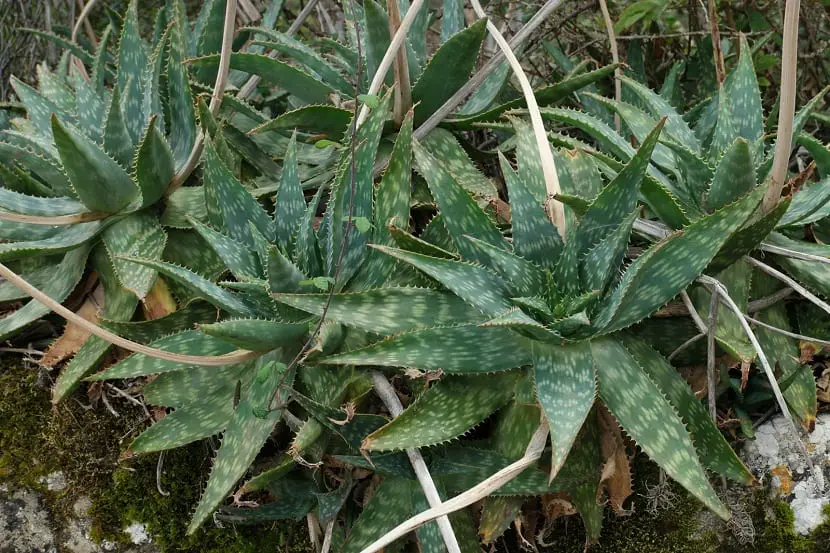
The spotted aloe It is a succulent plant that is part of the aloes family, it comes from the regions of South Africa, although also, given its ornamental use, it is cultivated in several countries.
Features

This small-sized plant reaches a height of 30 centimeters and sometimes reach 1 meter, with leaves in the form of a rosette, of a bluish greenish tone and, in case of being directly in the sun, they obtain a reddish tone, these are quite thick and wide.
They have white spots 20 centimeters long. It has brown spines on its margins. The flowers are tubular, appear in terminal inflorescences, branched and have an orange and red hue. Its flowering occurs during the winter until spring begins. Its stem is short.
Aloe maculata cultivation
The recommended exposure is semi-shadowand it is not suitable for you to be in cold areas that are below five degrees centigrade. The soil can be mixed between coarse sand, garden soil, and peat with leaf mulch.
It should be watered moderatelyalthough these plants have great resistance to the dry season. However, you should increase the number of times you water it a bit during the summer, always waiting for the soil to dry before adding water again.
They do not need to be pruned or specific fertilizers for their growth. They have great resistance, so it is not frequently affected by pests or diseases. Its multiplication can occur through the suckers that the plant generates at its base. It also resists the proximity of the sea, in a soil with good drainage.
Uses
It can serve in an ornamental way for gardens, rocky areas, patios, among others. What’s more, its development in a pot is not the same as in the groundso this can be an advantage if you want to have control in a garden.
It also has various medical usesThe main of these being the capacity it has to help tissue regeneration, healing, toning. Used for wrinkles, stretch marks, hair blemishes as well as having another great variety of properties.
Its use will always be linked to cosmetic items, however, the plant also has numerous other positive effects. Beyond skin affectations, can be used for its anesthetic elementswhich help relieve pain or reduce inflammation of the muscles.
They also have great nutritional contributions since it has minerals, vitamins and sugars. It is also used for the treating diseases such as arthritiscongestions in the intestines and parasites, cellulite, ulcers and in treatments to fight cancer, according to professionals.

Its use as a shampoo is also quite common, just by adding 10% of the gel in the shampoo you use you will obtain excellent results, since its effect is direct from the roots to the ends. You can also add fabric softenersince the gel can be completely absorbed without any trace of it.
The saponaria, different from aloe vera, has low levels of aloin per leaf. This substance is quite bitter and it has an intense odor, with very high laxative properties, which in quantities can have a toxic effect on people. As for the saponaria, the low levels of aloin make it a plant that can be eaten or drunk without any problem.
It has no strong odors or flavors and can be easily mixed with other beverages and foods for consumption. Nevertheless, due to the complexity of its compositionit is possible that it causes allergies in people who may suffer from this condition, so, before using it, you should consult a specialist.
This plant has a large number of benefits at the medicinal level, being very useful for various aspects of our daily life, which will help us to solve all these problems in a natural and effective way. In the same way, they are plants that you can have in your garden and have them available as many times as you need to use them for your medicinal treatments.
